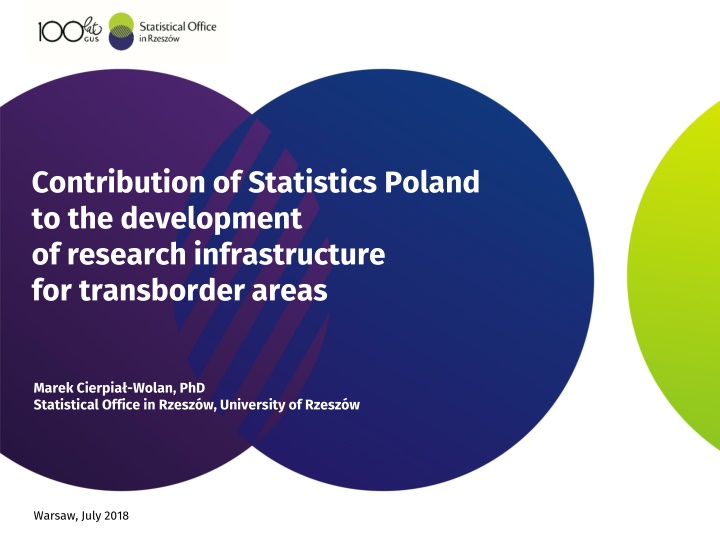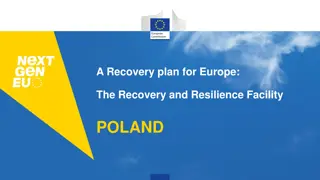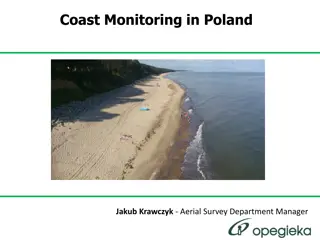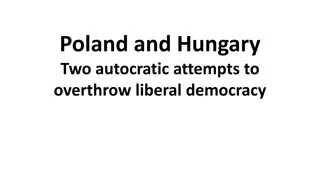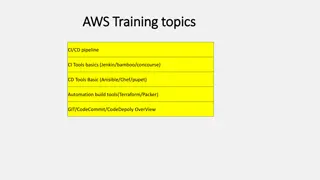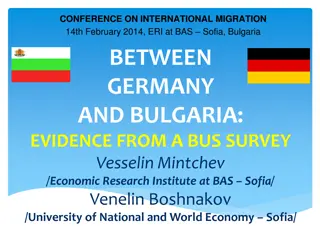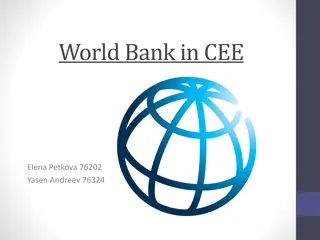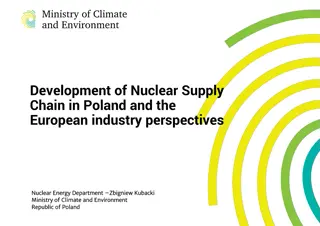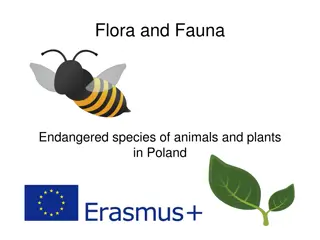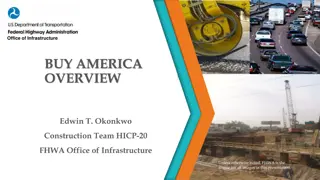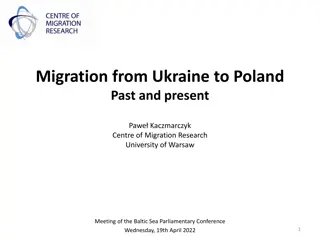Development of Research Infrastructure for Transborder Areas in Poland
Poland's contribution to the development of research infrastructure for transborder areas is highlighted in this presentation by Marek Cierpia-Wolan, PhD. The focus is on creating a coherent research system, delimiting transborder areas, monitoring socio-economic phenomena, and identifying data sources to foster cross-border collaboration and knowledge transfer.
Download Presentation

Please find below an Image/Link to download the presentation.
The content on the website is provided AS IS for your information and personal use only. It may not be sold, licensed, or shared on other websites without obtaining consent from the author.If you encounter any issues during the download, it is possible that the publisher has removed the file from their server.
You are allowed to download the files provided on this website for personal or commercial use, subject to the condition that they are used lawfully. All files are the property of their respective owners.
The content on the website is provided AS IS for your information and personal use only. It may not be sold, licensed, or shared on other websites without obtaining consent from the author.
E N D
Presentation Transcript
Contribution of Statistics Poland to the development of research infrastructure for transborder areas Marek Cierpia -Wolan, PhD Statistical Office in Rzesz w, University of Rzesz w Warsaw, July 2018
Presentation plan 1. Towards coherent research system for transborder areas 2. The structure of the research system 3. Networking and knowledge transfer 4. Conclusions 2
Transborder areas Transborder regions classified at NUTS 3 level: 40% of Europe's territory 30% of European GDP 150 million people 3
Socio-economic processes in transborder areas DIFFERENCES IN POTENTIALS INTEGRATION DISINTEGRATION INCREASE IN INTERACTIONS BETWEEN OBJECTS HIGHER INTENSITY OF NON-REGISTERED SOCIO-ECONOMIC PHENOMENA DEEPENING FAILURES IN INFORMATION SYSTEMS 4
Towards coherent research system for transborder areas Delimitation of transborder areas Transborder metadatabase Methodology Monitoring of socio-economic phenomena Comprehensive surveys 5
Delimitation of transborder areas Distance from the border to the place of purchase of Poles and foreigners crossing the EU s border in Poland o Preliminary delimitation based on: Regulation No. 1931/2006 of the European Community, according to which the border zone covers an area of 30 to 50 km from the border, Commuting (administrative registers) etc. o Dynamic analysis of socio-economic phenomena in this area and its vicinity (e.g. labour market, entrepreneurship, demographic processes, tourism, differences in the level of prices). delimitation - systematic 6
Monitoring Identification of data sources o Administrative registers and statistical databases, o Inventory of information resources of official statistics, o Combining information from the administrative registers, Big Data sources and sample surveys. (e.g. the linkage of data from sample surveys (the Labour Force Survey, the Household Budget Survey, the Survey of Goods and Services Turnover and Social Diagnosis) to data from the mobile phone operators, automatic points of road traffic measurement, bank information systems, etc.) 7
Monitoring Linkage of data from different sources o Air traffic data on 63717 flights obtained by day-by-day webscraping 29 airports: 15 Polish airports and 14 hub airports (selected according to traffic intensity from Polish airports), Data consist of (origin and destination airport, IATA and ICAO codes, type of aircraft, date of arrival and departure); o Supplementary information register of IATA, ICAO and FAA codes for retrieving origin and destination country, technical information on aircrafts (seats, type of aircraft, airline), administrative data from Civil Aviation Authority of Poland on number of passenger from Polish airports, sample survey on tourism conducted in households by Statistics Poland; o Main objective: higher number of countries included in the estimation of BoP, higher precision of estimations. 8
Monitoring Linkage of data from different sources Distribution of trips based exclusively on sample survey and with Big Data. We obtained estimates for 145 countries while the sample survey covers up to 80 countries. Combining Big Data and sample survey ensures much less randomness in distribution of trips then the sample survey. 9
Monitoring Linkage of data from different sources Distribution of trips based exclusively on sample survey and with Big Data. The difference between expenses made by Poles and foreigners at the border crossing in J drzychowice based exclusively on the sample surveys and based on combined information sources (sample survey and data from automatic road traffic measurement). 10
Monitoring Economic Social Economic Social Factors of regional development Quality of life Ecological Quality of life Political Legal 11
Quality of life Pilot survey o Carried out on around 3000 households in Poland and Ukraine including transborder areas; o Questionnaire - 96 questions on Likert scale; o Subjective assessment of life domains such as social, economic and intellectual aspects of life, health, activity, community, preferences, prospects and expectations. 12
Subjective and objective aspects of quality of life Synthetic indicators Selected objective indicators of quality of life Subjective assessment of life domains on Likert scale o Average monthly gross wages and salaries o Sold production of industry per 1 thous. population o Average usable floor area of a dwelling per one inhabitant o Registered unemployment rate o Proportion of registered unemployed persons in population at working age o Population using wastewater treatment plants in % of total population o Proportion of waste recovered in waste generated o Persons unemployed over 24 months per 1 thous. population o Full-time and part-time paid teachers in terms of full-time employment per 1 thous. population o Percentage share of schools equipped with computers with the Internet access o Total nursery schools per 1 thous. population o Total tertiary schools per 1 thous. population o Total students per 1 thous. population o Doctors and dental specialists per 1 thous. population o Beds in general hospitals per 1 thous. population o Nurseries and nursery wards per 1 thous. population o Ascertained crimes per 1 thous. inhabitants o Proportion of green areas in total area o Total respiratory diseases per 100 thous. population o Total deaths caused by neoplasms per 100 thous. population o Deaths caused by circulatory system diseases per 100 thous. population o Family life o Financial situation o Friendship o Incomes o Meeting basic needs o Health o Achievements o General country situation o Housing o Neighbourhood o Available goods and services o Prospects o Sex life o Education level o Leisure o Job o Children o Marriage o Safety 13
Quality of life - Distortion measure 1 0.9 0.8 0.7 Objective Measure 0.6 0.5 0.4 0.3 0.2 0.1 0 0 0.1 0.2 0.3 0.4 0.5 0.6 0.7 0.8 0.9 1 Subjective Measure Polish and Ukrainian households in inner area Polish households along Ukrainian border Ukrainian households along Polish border Polish households along Slovakian border Polish households along Slovakian border Polish households along Ukrainian border Ukrainian households along Polish border Polish and Ukrainian households in inner area 0,555 0,562 0,584 0,384 Formula Formula 14
Comprehensive surveys Survey at the EU s borders on the territory of Poland Household survey e.g. tourism, quality of life common questionnaire External borders Internal borders Questionnaire survey at the border Traffic intensity survey Questionnaire survey in the vicinity of the border (e.g. shopping centres, service centres, petrol stations) Questionnaire survey (seaports, airports, railway) 15
Summary of the methods Kinds of survey Research instruments Frame Sampling Simple Random Sampling with Stratification Household Survey Frame Sample survey Questionnaire Internal/ external border Systematic Sampling Sample survey No frame Questionnaire Vicinity of the border Sample survey No frame Purposive Questionnaire Border Traffic Survey - - Census survey Register 16
Special procedure of data processing Questionnaire survey at the border and in the vicinity of the border (e.g. shopping centres, service centres, petrol stations) Questionnaire survey (seaports, airports, railway) Traffic intensity survey Questionnaire survey in households Preliminary weights DataBase Final weights Direct estimate Weights calibration Three-part structure Constrained Least Squares Method Constrained Least Squares Method Final estimate of key variables Final estimate of all variables Modelling Raking Extra-statistical sources of information and expertise Raking 17
Survey at the European Unions external border Expenses on the purchase of goods incurred by foreigners in Poland and Poles abroad who crossed the EU s external border on the territory of Poland by countries in 2016 Countries: Countries: 256.4 4.9 Russia Russia 63.2 0.6 525.4 43.2 Belarus Belarus 15.9 2.0 1,747.0 50.6 Ukraine Ukraine 2.1 41.2 million EUR % 60 50 40 30 20 10 0 0 500 1000 1500 2000 Expenses : Foreigners Poles Foreigners expenses/export relation million EUR 2500 2000 1500 1000 500 Years 0 2008 2009 2010 2011 2012 2013 2014 2015 2016 Foreigners Poles 18
Expenses of foreigners in Poland and Poles abroad who crossed the EU s external border in 2016 Spatial breakdown % 39.1 40.0 expenses-to-export ratio expenses-to-import ratio 35.0 30.0 25.0 20.0 15.2 14.6 15.0 10.0 4.0 3.4 2.2 5.0 0.8 0.5 0.0 lubelskie podlaskie podkarpackie warmi sko-mazurskie Regions (NUTS 2) 19
Networking and knowledge transfer Pilot-project Cross-border data collection Objective: Development of methods for cross-border areas Consortium: PL, DE , BE, FR, DK, IT, SI and NL (lead) Focus: Labour market statistics Contents: 1a. Better use of Labour Force Survey 1b. Use of administrative data 2. Exploring mobile phone data (NL&BE) Expected publication final report: September 2018 20
Transfer of knowledge Project The use of multi-method surveys as illustrated by the example of integrated surveys on trips Objective: Transfer of knowledge and experience of Statistics Poland in the field of providing relevant information and analyzes for the needs of tourism statistics, national accounts and balance of payments, and in the area of development of systems monitoring the phenomena occurring in border areas. Focus: Integrated surveys on trips: Trips made by non-residents to Poland. The movement of vehicles and persons at the Polish border with the countries of the European Union, Participation of Polish citizens (residents) in trips. Content: Different sources of information from administrative registers and statistical databases. Multi-method approach in developing integrated surveys on trips Typology of cross-border areas in Ukraine. 21
Conclusions o Unique character of transborder areas requirement for uniform information infrastructure and base of knowledge on transborder areas. o Polish official statistics - various actions concerning the use of different sources of information, monitoring socio-economic phenomena in transborder areas, and improving and designing new surveys for transborder areas coherent research system for transborder areas. 22
Conclusions o The results of launching the system: significant differences in the behaviour of both households and enterprises, the need to use innovative methodological solutions in research system for transborder areas, combination of sources of information (statistical databases, official registers, administrative sources of data, bank registers, automatic measurement of traffic, other Big Data sources), transborder metadata shell and transborder metadatabase in order to guarantee standardization, identification, consolidation, integration, interpretation, evaluation documenting of data and deliver process data; o The practical use of such an information infrastructure - on the local, regional, national and international level. 23
Conclusions Necessity of distinguishing statistics in the domain of transborder areas within the information system of official statistics Public health statistics Trade statistics Tourism statistics Demography statistics Labour market statistics Statistics in the domain of transborder areas statistics Industry statistics Transport statistics Education statistics Agriculture statistics Construction statistics 24
Thank you for your attention More information: rzeszow.stat.gov.pl Marek Cierpia -Wolan, PhD 36 Warsaw, July 2018
Distortion measure It is based on unitarized subjective and objective indices of quality of life. Its construction allows one to measure the distance between observed data and the model. where: si- subjective unitarized synthetic index, oi- objective unitarized synthetic index. This measure takes values from 0 to 1. In the case of using unitarized indices for ranking units it has the following interpretation: it equals 0 if observed data is a perfect match with the model; it equals 1, otherwise. 26
Raking B1 B2 B3 B1 B2 B3 A1 x11 x12 x13 A1 x11 x12 x13 A2 x21 x22 x23 A2 x21 x22 x23 27
Constrained Least Squares Method Let x, w, c, D be a vector of initial weight, final weights, constraints and variance-covariance matrix, respectively. The objective in least squares problem with linear constraints is to provide a solution for minimizing a sum of squares (w - x)TD (w - x) with respect to linear constraints Hw = c. Using method of Lagrange multipliers we obtain the solution o the form w = x + D -1H (HD-1H )-1(c - Hx) 28
Business demography Dynamics of the number of entities per 1000 inhabitants (2010=100) 112 110 108 Total 106 Whole area 104 Polish_Russian 102 Polish-Belarusian 100 Polish-Ukrainian 98 96 94 2010 2011 2012 2013 2014 2015 o The number of firms in the border area as a whole was increasing better than in Poland, especially by the Polish-Belorussian border; o Economic slowdown caused a significant decrease in the number of firms between 2010-2011; o The turning point is 2011 when we can observe a steady increase in dynamics in all analysed areas. 29
Business demography Dynamics of the number of entities with foreign capital participation per 10 000 inhabitants (2010=100) 190 170 Total Whole area 150 Polish-Russian Polish-Belarusian 130 Polish-Ukrainian 110 90 2010 2011 2012 2012 2014 2015 o Systematic increase in this indicator signifies that border areas are becoming a more and more attractive place for foreign investments, especially near the Polish- Ukrainian border. 30
Financial health - fundamental analysis Return on equity 13.0% 12.0% Total 11.0% Whole area Polish-Bialorusian 10.0% Polish-Czech Polish-German 9.0% Polish-Slovakian 8.0% Polish-Ukrainian 7.0% 12-2008 12-2009 12-2010 12-2011 12-2012 12-2013 12-2014 12-2015 o Enterprises of the border area show slightly better return on equity than the average for Poland; o The lowest return on equity was reached by enterprises by the eastern Polish border, in 2009-2011 by the border with Ukraine in particular, and in 2012-2013 near the border with Belarus; o In the analysed period, the best results were obtained by the enterprises by the Slovakian border, even 2 percent points more compared to the national average. 31
Demographic typology (Webb Method) Natural increase 4.0 V CHODN SLOVENSKO A H B 3.0 WOJEW DZTWO PODKARPACKIE C 2.0 ZAKARPATSKA OBLAST 1.0 Net migration NORD-EST CENTRU 0.0 -6.0 -5.0 -4.0 -3.0 -2.0 -1.0 0.0 1.0 2.0 3.0 4.0 NORD-VEST IVANO-FRANKIVSKA OBLAST -1.0 CHERNIVETSKA OBLAST D -2.0 SZAK-ALF LD -3.0 LVIVSKA OBLAST SZAK-MAGYARORSZ G -4.0 G E F -5.0 2008 2016 32
Demographic typology (Webb Method) 2008 2016 33
Monitoring social processes Changes in the number of population 2008 2016 Carpathian Euroregion (in million persons) 15,5 15,2 -0,3 34
Monitoring social processes Population aged 65 and over in % of total 2008 2016 Carpathian Euroregion (share in %) 12,6% 15,2% 35
